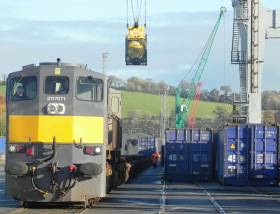Displaying items by tag: Irish Rail Freight trials
#LongerTrains - Irish Rail (Iarnrod Éireann) reports Multimodal, have recently completed a series of three freight train trials that will enable loads to be increased by 50%.
The final trial late last month involved a multimodal service operated from Dublin Port (North Wall) to Co. Mayo. As previously reported on Afloat the same service conducted its 1,500th train almost a year ago transporting containers.
Until this latest trail, trains on this route have been operated with a maximum of 18 wagons (36 TEUs) and this trial has now pushed the limit up to 27 wagons (54 TEUs).
The train, hauled by one of the class 201 General Motors diesels, the most powerful to operate in Ireland, was 440 metres long with a trailing load of 1,110 tonnes. The train, operated on behalf of International Warehousing & Transport of Dublin (IWT) is the longest commercial freight train to operate over the Iarnród Éireann network.
Recently a trial of an 18 wagons, 390 metres long, 1,100 tonnes pulpwood train also operated successfully between Limerick and Waterford Port.
Longer trains on the network will boost the competitiveness of rail freight to industry. The environmental benefits of rail freight would also be enhanced by operating higher capacity services – currently moving freight by rail instead of road reduces emissions up to 75% per unit, and longer trains could see emissions reduced to as little as one-tenth of the road equivalent.
Iarnród Éireann General Manger, Rail Freight, Glenn Carr said that Iarnród Éireann is currently working with existing customers as well as Freight Forwarders, Ports and the Irish Exporters Association to identify further opportunities and trends for rail freight development within the Irish and European market. In 2015, 96.4 million tonne kilometres of freight were moved by rail in Ireland.
Principle rail freight traffics on the Irish network currently include:
- Container traffic from Ballina to Waterford and Dublin Ports
- Pulpwood from Ballina and Westport to Waterford Port
- Zinc ore from Tara Mines in Navan to Dublin Port
Subject to the successful conclusion of trials, the company expects to begin operating longer freight trains from fourth quarter 2016.





























































